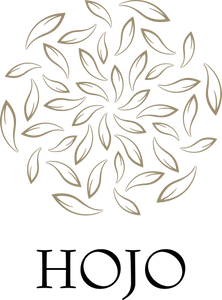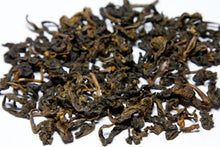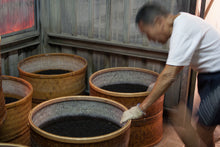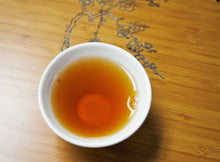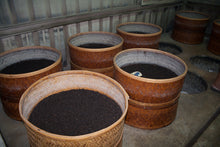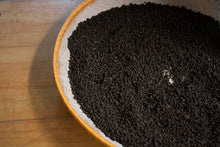
This tea is a very exclusive tea even in Taiwan. It takes 30 years to get vintage quality which is very rare to find in Taiwan. 30 years of storage makes tea extraordinarily smooth, no bitterness or astringent taste, and it is suitable for any generation in a family.
Some people may worry that 30 years of storage will caused tea to develop musty flavor like old furniture. For this 30 years vintage oolong, it's totally not like this. Tea gives a smooth taste with comfortable toasted aroma like dried fruits, Tea is kept well with proper storage method in Taiwan, and the tea maker will check the condition carefully. Normally after a few years, tea will be baked with traditional charcoal fire to reduce the moisture content and to awaken the tea, and then continue for aging. When brew, tea has a clear copper-red liquor.

In order to produce premium vintage tea, it is not only 30 years of time that is important, but also the material used. Selecting the good material that contains rich constituents, tea can withstand the long storage.
Tea leaf is checked at regular intervals and dried if it shows excessive moisture content in order to protect the tea leaf from mold infection and quality deterioration. The drying method is one of the important factors that affects its quality.
When you drink this tea, you feel a dried fruity flavor. 30 years of maturation makes taste extremely smooth just like vintage brandy.
The HOJO's Vintage Oolong is only made by veteran tea master who devoted his life for baking this tea. He selected the most suitable charcoal which produces good fire without unpleasant flavor. With good charcoal, it gives a very refreshing drinking feeling which is Elegant, yet Very Easy to drink.
1. History and Culture
It was a tradition in Taiwan to keep good oolong tea in a pot and preserves it for many years. Since it takes unimaginably long time and extensive care to produce this tea, it is a very rare tea even in Taiwan and one could hardly obtain the high end quality.
2. Production Area

Tea Garden
Fog plays an important role. It makes tea leaves tender and less bitter taste.
For HOJO's Vintage Dong Ding Oolong, the original tea leaf was produced 30 years ago from the Dong Ding Mountain area. Unfortunately, this oolong tea, produced at Dong Ding Mountain is getting very rare nowadays on account to its increasing demand and reputation. Many tea cultivators try to produce it at a lower cost and in larger volume which is more than that produced at the tea garden at Dong Ding Mountain. It is rather difficult to find genuine Dong Ding Oolong that is from Dong Ding Mountain. In Taiwan, people also start recognizing that Dong Ding Oolong means it's one Type of Tea, the semi-fermented oolong tea.
However, HOJO only introduces the genuine Dong Ding Oolong. Dong Ding Mountain is not only famous for its name, but most importantly, its environment and weather is ideal for high grade tea. The altitude of this mountain is not that high, which is at around 1000m plus. The secret of Dong Ding Mountain is that it always produces identical quality is because of its weather and soil condition. The tea garden gets very strong sunshine in the morning, but it is completely covered by fog in the afternoon. In addition, the environment is very windy, and the soil condition is less rich in nutrition. This severe environment causes the tea leaves to accumulate a lot of substances and leaving it no chance to consume these substances. That's the reason why tea produced at Dong Ding Mountain gives a very strong flavor and sweet after taste.
3. Cultivar and Plucking

Tea Garden
HOJO's Vintage Dong Ding Oolong is produced from Qing Xin Oolong Cultivar. The tea produced from this cultivar gives refreshing and delicate taste. Tea leaf is from the organic tea garden. As compare to the garden practice pesticide application, the production quantity in organic tea garden drops drastically. Tea leaf was plucked 30 years back in 1976. Plucking of tea leaf was conducted fully by hands. Usually one twig that consists of 3-4 leaves were plucked.
4. Processing
Sunshine Withering
After plucking, tea leaves are spread over the ground under the sunshine. It is called Sunshine Withering. Usually clouded weather is ideal to grow this tea in order to avoid excess damage on tea leaves. If the sunny weather continues, a black cloth is used to cover the tea leaves to block out the harsh rays of sunshine. With sunshine withering, moisture inside the tea leaf gets evaporated and fermentation is moderately triggered. The tea leaf will gradually start releasing a refreshing aroma.
Indoor Withering
The method of fermentation for oolong tea is completely different from that of black tea. After the sunshine withering is completed, tea leaves are conveyed into the factory and spread over a sheet. If tea leaves are rich in moisture, they are spread into a thin layer in order to increase the evaporation process. The tea leaves are then tossed onto a bamboo tray. This agitation and tossing, causes friction which in turn causes the tea leaves to start fermentation. The tray is then placed on a rack and these processes are repeated over and over again. This is what is called fermentation. Tea leaves gets oxidation mediated by the oxidation enzyme when the tea leaves get bruised.
Once entering the fermentation room, you might get surprised with its fragrance. You feel as if you are in a flower garden. Subsequently tea leaves are rotated in a bamboo drum. The tea leaves are lifted and dropped several times. Gradually the edge of tea leaves get damaged and further fermentation takes place. Tea leaves are again spread over the bamboo tray and the same process is repeated over and over again.
Once tea leaves get sufficient fermentation, it starts generating a flowery fragrance. Tea that is processed by a skilled tea master is easily distinguishable. The original shape is maintained without any damage done to the tea leaves and only the edge of tea leaves are found to be red in color. This indicates that the tea leaves were successfully semi-fermented and the quality is far different from the tea leaves which have a reddish appearance at the center part of the leaf. Once the tea master finds that fermentation is sufficiently achieved, the tea is then sent for heat treatment in order to arrest further fermentation process. If this is not carried out swiftly, the tea leaves will keep on fermenting and it will finally turn into black tea.
The number of rotation and timing of fermentation is judged based on the moisture content, flavor and color. This decision requires top-notch experienced tea technicians which affects the quality of tea tremendously. All technicians follow the instruction of a tea master. In order to get good quality tea, we need to pick out an excellent tea master.
Rolling
At this stage, tea is fermented and giving an identical characteristic of Dong Ding Oolong. However, tea leave has not been damaged or bruised except for its edge. Without physical damage on tea leaf, it is difficult to "brew". On the other hand, conducting the rolling process as black tea that tea leaf is twisted tautly under the strong pressure, tea leaf will be over damaged and get astringent and harsh in taste. In addition, excessive damage of leaf will expose constituent to the oxygen and cause unwanted oxidation that will also affect to the taste and flavor. Therefore, the very unique rolling process called "Bag rolling" is used for oolong tea. Literary, tea leaf is bagged with a cloth and rolled. Therefore, tea leaves are twisted just right with the right amount of pressure applied.
While the tea leaves are still warm and soft, it is quickly wrapped in cloth bag. About 10-20kg of tea leaf is wrapped and it is made into the size of about a basket ball. Then the end of cloth is mechanically twisted by machine in order to squeeze it into a very solid ball. Finally it becomes as solid as a stone ball and as a result the tea leaves are compressed very tightly.
Then, the cloth ball is clamped between two disks at the top and bottom. The top disk does not move while the bottom disk rotate and tea gets further pressure through the motion. After the rolling process is conducted for a while, the bag is opened and the tea leaves are taken out and reheated again in a rotating drum. This is necessary as once the tea leaves cool down, it becomes crispy and easily crushed. This series of processes are repeated several times until it is well rolled.
The tea leaves are gradually tighten and become round in shape. High grade tea is usually very solid and it appears to be dark and shiny as the juice of the tea leaf is squeezed and hardens on the surface of the leaf.
The same sequence is repeated over and over again. The parameter is varied depending on the condition of leaf such as moisture content. It is important to feel the condition of tea leaf and apply the suitable method of process which is judged expertly by the tea master.
After this rolling process is completed, the tea leaves are dried and this will reduce the moisture content down to 5%.
Maturation
Likely to the vintage brandy, this vintage tea shows similar characteristics. When keeping the high quality oolong tea for long time, tea is naturally matured and taste become very sweet and you would enjoy a dried fruity flavor. Traditionally, tea is stored inside a pot. But the detail of this method is varying depends on the factory. Most importantly, the moisture content of tea leaf must be checked at regular intervals and drying of tea leaf has to be carried out once the moisture content of tea leaf increased up to certain level.
At last vintage oolong is "wakening up". Using a basket made from bamboo called Hong Long (烘籠), tea is gently baked with charcoal fire. According to the vintage tea master, the selection of the charcoal is a very important factor as the fire made from good quality charcoal does not generate unpleasant flavor. When we visited the factory, old tea master who is about 60-70 years old was quietly, yet effectively working there. The Hong Long room was extremely warm like sauna. But surprisingly we felt no smoky smell at all. Using the good charcoal and saturated fire, tea leaves will be well baked and flavor that was "sleeping" inside the tea leaves for the past 30 years will be literally "awaken".

The Firing Process is carried out by old tea master.

Veteran tea master is processing the vintage tea.

Hong Long is placed on the top of charcoal fire.

There is a layer of mesh in the middle of Hong Long. Tea leaves are spread into a thin layer and baked.

